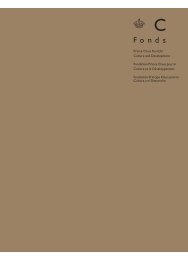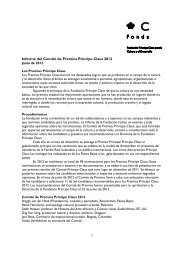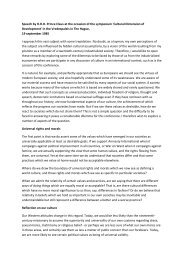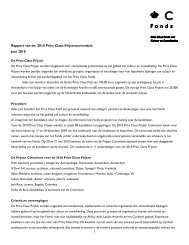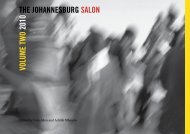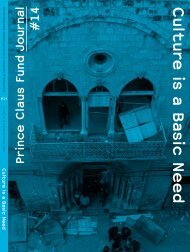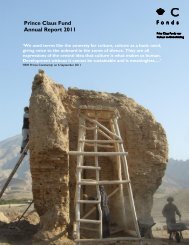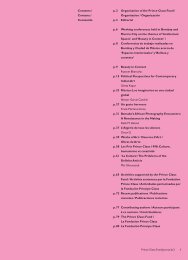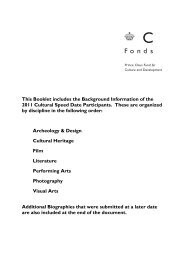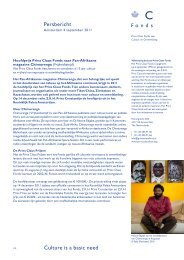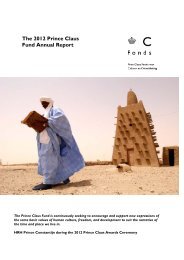3 summer 2011 - Prince Claus Fund
3 summer 2011 - Prince Claus Fund
3 summer 2011 - Prince Claus Fund
- No tags were found...
Create successful ePaper yourself
Turn your PDF publications into a flip-book with our unique Google optimized e-Paper software.
030–053talattekin_alt:turklergaram 29.11.2007 9:22 Uhr Seite 52mary long vowels in standard Turkish: Azeri Turkish a:ç “hungry”> Khaladj a:ç, AT a:t “name” > Khal. a:t, AT a:ş- “to exceed”> Khal. a:ş-, AT kı:z “girl” > Khal. qi:z, AT i:ş “work” > Khal. i:ş,AT ho:t “fire” > Khal. hu:ot, AT be:ş “five” > Khal. bi:eş, AT e:şik“door” > Khal. i:eşük, AT kö:ñ- “to burn” > Khal. kien-, etc.9. The second most important feature of Khaladj is thepreservation, as in Tuva, of the /d/ sound in Proto-Turkic: AzeriTurkish hadak “foot” > Khaladj hadak (Tuva adak, Yakut atax,Khakas azax, Turkish ayak), AT e:di “owner” > Khal. eydi(Orkhon idi, Uighur iyä, Turkmen eye, Azeri Turkish yiyä, YellowUighur eydi), AT kuduruk > Khal. kudruk (Old Turkic kuduruk,kudruk, MK kudruk, Tuva kuduruk, Khak. xuzurux, Yak. kuturuk,Trk. kuyruk), etc.10. Finally, Khaladj syntax reveals Persian influence,more particularly in sentences combined with /ki/.A few sentences in Khaladj: Bu här häyli karrımış, bi:hadakı o dunyaçar “This man is quite old; he has one foot in thenext world”; Hadakuy iö:z gälimi gadar uza:tı “Stretch your legaccording to your kilim!” Män şä:rkä kälän dağam “I haven’tcome to the city”; Yol havul dağ ärti “Yol iyi de€il idi”; Här näviergülükär kälitür vierür “He will bring and give whatever is necessary”;Här nä şäygäy säyä vierüm “I’ll give you whatever youwant”; Män taqi bi: zo:di: ha:yguluk dağam “I have nothing elseto say”; Häri: va:rarti ki a:ti Ha:tumarti “There was a man calledAd› Hatum”; Män särguzäştim bi: towrar ki haymaguluk dağ “Myadventure is of a kind that cannot be described.”XI. atax GROUPA. The Yakuts and Their LanguageThe Yakuts are a Turkic people inhabiting the YakutAutonomous Republic of the Russian Federation in the extremenortheast corner of the Turkic world. Small Yakut communitiescan also be found in Magadan (eastern Russia) and onSakhalin Island. According to the 1989 census, there were382,225 Yakut speakers in the former Soviet Union. This maywell have risen to 400,000 at the present day.The Yakuts refer to themselves as Saxa. This term, likethe word Yakut itself, derives from the Turkic word yaka. TheYakuts may be the descendants of the Y›r Bay›rku, whose nameappears in the Orkhon inscriptions. The Yakuts are thought tohave migrated to their present-day homeland during theMongol period. Although the Yakuts are officially Christian, theyhave not entirely forgotten their ancient shamanism. Yakut,which emerged as a written language after the Soviet revolution,has a number of dialects, which can be divided into threegroups: (1) Nam-Aldan (xatın “woman,” seri:n “cool”), (2)Kangal-Vilyuy (xotun “woman,” sörü:n “cool, coolness”), (3)Dolgan (katun “woman,” serü:n “cool, coolness”). In the nineteenthcentury, Yakut was written using a Cyrillic alphabet preparedby Russian missionaries and linguists such as Otto vonBöhtlingk and E. K. Pekarsky. In 1917, the Yakut educator andlinguist S. A. Novgorodov developed an alphabet based on theLatin alphabet; with a few modifications, this was used until1938. In 1939, it was replaced by a Cyrillic alphabet, which isstill in use. Yakut displays a number of archaic features. It formsa very important branch of the family of Turkic languages. Ofall the Turkic languages, it is the closest to Tuva, although themutual intelligibility ratio between Yakut and Tuva is zero.52LANGUAGE AND IDENTITYAround 50 percent of the Yakut vocabulary consists of Mongolborrowings. The principal characteristics of Yakut are the following:1. The primary long vowels in Common Turkic are regularlypreserved or geminated: Common Turkic a:t > a:t “name,”CT be:ş > bies “five,” CT qı:z > kı:s “girl,” CT bi:r > bi:r “one,” CTho:t > uot “fire,” CT bu:z > mu:s “ice,” CT kö: l > küöl “lake,” CTkü:ç > kü:s “strong,” etc.2. The development of the Old Turkic /a€/ group into/›a/: Old Turkic tağ “mountain” > tıa “forest,” OT bağ > bıa “vineyard,”OT sağ- > ıa- “to milk,” etc.3. The change of the Old Turkic medial or final /d/ to /t/:Old Turkic adaq “foot” > atax, OT adgır “stallion” > atı:r, OT ädgü“good” > ütüö, OT tod- “to be satiated” > tot-, etc.4. The disappearance of the initial /s/: sağ- > ıa- “tomilk,” sän > en “you,” sämiz > emis, söz > ös, säkiz > ağıs“eight,” etc.5. The change of the initial consonant /y/ to /s/: AT ya:z“spring” > sa:s, AT yo:l > suol “road,” yat- > sıt- “to go to bed,”yıl > sıl, yer > sir “place,” etc.6. The change of the initial and final /s/ to /t/: Old Turkicisin- “to grow warm” > itin-, OT isit- “to warm” > itit-, OT yastuk“pillow” > sıttık, OT ini-si “his brother” > ini-te, etc.7. The change of Old Turkic /ç/, /fl/, and /z/ at the endof a word or next to consonant to /s/: Old Turkic çäriğ “army” >seri: “war, army,” OT saç > sas, OT be:ş “five” > bies, OT qı:z“girl” > kı:s, OT yü:z “one hundred” > sü:s, etc.8. The change of the secondary /s/ consonant derivedfrom Old Turkic /ç/, /fl/, and /z/ between vowels to /h/: OldTurkic üçün > ihin “for,” OT yaşıl “green” > sahıl “fox,” OT uzun> uhun, OT üçünç > ühüs “third,” OT beşinç > behis “fifth,” Yakutkı:s “girl,” kı:ha “his daughter,” etc.9. An important morphological feature of Yakut is theabsence of the -sız/-siz suffix, as seen in the use of the wordsuox to signify absence: tıl-a suox “dumb” (i.e., “a person whois not smart”), u:-ta suox sir “waterless, dry” (i.e., “a place wherethere is no water”), etc.10. The lack of a genitive suffix is one of the most importantfeatures of Yakut: saxa tıl-a “Yakut language,” saxa tıl-ıngrammatika-ta “the grammar of the Yakut language: (the -ın inthe word tılın is the original form of the third person possessivesuffix).A few sentences in Yakut: Xaydax oloroğut? “How areyou?” Min saxalı: kıratık öydü:bün “I understand a little Yakut”;En olus türgennik sangarağın “You speak very quickly”; Bihigisarsıarda erde turabıt “We get up early in the morning”; İti oğotü:nneri ıtı:r “That child cries at night”; Olorbutta:ğar ülele:bitorduk, “Work is better than just sitting.”B. The Dolgans and the Dolgan DialectThe Dolgan dialect of Yakut is spoken by some 10,000people in the Taymur Peninsula, a long way from Yakutistan.The Dolgans are a Yakuticized Tungus tribe.The Dolgan dialect differs from Yakut in several features:1. The systematic retention of the Old Turkic initialpostvelar /q/ sound: katun “woman” = Yakut xotun, katıng“beech tree” = Yakut hatıng, kol “shoulder” = Yakut xol, kon- =Yakut xon-, etc.<strong>Prince</strong> <strong>Claus</strong> <strong>Fund</strong> Reader #1 · Summer <strong>2011</strong> · 62



